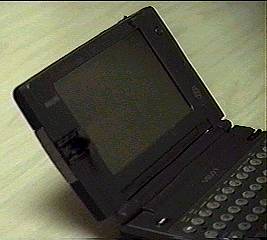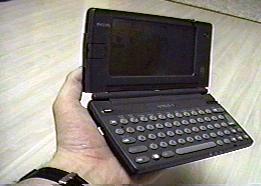











Last updated: 25/03/05 02:06:57 PM
Welcome to the Unofficial Philips Velo FAQ!
designed & hosted by
Please note: The Velo series has been discontinued, and in fact, Philips has pulled out of Windows CE all together (their mistake). I no longer own a Velo 1 or Velo 500, so I don't have the CD-ROM with the updated 2.0 software, I don't have a ROM chip to sell anyone (check ebay), and I can't provide support for the devices in any capacity. I'll leave this site up as a resource for everyone, but I am unable to answer support questions on specific Velo issues. Please check the Windows CE Newsgroup FAQ for more general Q&A's.
If you're looking for Philips software downloads for the Velo and Nino series machines, go here. If you can't find it there, then I have no idea where it will be. :-)
Make sure you check the What's New page for all the latest info!
The goal of this FAQ is to provide Velo owners everywhere with a comprehensive, unofficial, and completely honest source of Velo-specific information, troubleshooting tips, and software reviews. Thank you to the countless individuals who helped me create the 1.0 version, specifically Paul Nash and Alvin Chen, and the many readers in the Windows CE newsgroups that helped me to build up the first-hand knowledge contained in this FAQ. I am in your debt.
The official Velo 1 FAQ is located on the Philips site here. It's absolutely massive, and I dare say it was modeled after my own 1.0 FAQ. It's very well done, and comprehensive. Bookmark it. They've even linked to my FAQ, although after they see this 2.0 version, that might change. Let's hope not! Despite my increasing role of "Velo Critic", I still love the unit and recommend it.
As an MVP (Most Valuable Professional) for Microsoft, my job is to provide as much help to the Windows CE community as possible. This is part of fulfilling my responsibility - I hope everyone learns from it!
As always, the What's New area is the place to check if you've been here lately. If you haven't been here in a while, roam through all the areas. Every section has been enhanced with new information, and I'd encourage you to let me know if you have any suggestions for this site.
And once you're done with this site, please feel free to examine the rest of my web site.
| Jason Dunn Kensai Design & Communications Microsoft MVP, Windows CE |
General Questions
What is the purpose of this FAQ?
This FAQ is designed to provide the curious reader with more information about common Velo questions. Our intended audience is new users of Velo devices or those looking for more information than a guy running to catch a late plane (the Velo commercial they’ve played way too many times in my area at least). We do not attempt to replace the VeloNet site, nor do we explicitly intend to provide technical support to solve all problems. We simply wanted to help others learn more about the best HPC there is.
If we haven’t answered your questions, then please feel free to post to msnews.public.windowsce or visit the velo.philips.com website. If you are a Velo owner, then you should have free access to VeloNet, via phone or website and they are the proper contacts for detailed problems – they’re quite good at it too.
How does the Velo 1 compare with 2nd generation machines like the HP 620LX and Sharp Mobilion 4500?
It's a difficult comparison - not really apples to apples. The Velo 500 will be PMCG's 2nd generation effort, so that's the one to compare it with.
As with all technology, examine your needs. The Velo 1 is currently (2/28/98) $399. The HP 620LX is about $835.99 (Insight), and the Sharp Mobilion 4500 is about $1000 (Insight). These prices might change, but I won't keep up to date - this isn't an HP or Sharp page! The Velo 1 is smaller and still faster than either CE 2.0 units. It's voice recorder is far better - and it's battery life is 2-3 times as long. Decide for yourself which one is the best for you.
What makes the VELO 1 different from other 1st generation HPCs?
The Philips VELO was designed to be the most "cutting edge" HPC, and was the first HPC on the market to significantly expand upon the Minimum Requirements for HPC's as specified by Microsoft. We also believe that the Velo will maintain this technological edge.
As well as having the standard HPC requirements, it has the following unique and semi-unique characteristics:
- Built-in modem: the VELO has a 19.2 (yes, it actually works at that speed when connected to a 28.8 modem at the other end) software-based modem, with software for sending faxes. It is also low power; you can surf for hours on a single charge, while normal PCMCIA modems will drain a charge in 15 minutes or less.
- Built-in voice recorder: the VELO has an external microphone on the shell that can be activated by an external button for recording voice memos, etc. This creates 8000 Hz WAV files that can be exported/imported as normal WAV files. While 8000 Hz isn't exactly "good sound", it can double as a personal recorder for sound effects/music in a pinch


- Software bundle includes AllPen Mobile Forms Database
- Highly upgradeable hardware (see below)
- External lights to indicate charging, communication, and appointment reminder
- Sleek design and a very nice outer shell made partially from soft plastic. Definitely the nicest looking HPC!
- Very fast - from all the reports I've seen, it's the fastest HPC on the market (having used the Casio and NEC, it was certainly much faster). With the new speedup program (see below), it’s definitely the fastest.

Does this make it better than other 1st generation HPCs?
As in all things, it depends on what you need in an HPC. It is my own opinions that there are two HPCs that stand out: the VELO, for its tremendous versatility and unique technology, and the Hewlett-Packard 320LX for its larger display and keyboard.
The 320LX, however, is severely lacking in upgradeability. Sadly, HP designed it to max out at 4 megs of system RAM. In my mind, this is a fatal flaw. You can expand it with Flash RAM, but this doesn't work the same as true DRAM. The HP keyboard, while quite nice to type on, isn't any better than the Velo's. They both make touch typing basically impossible. You're lucky if you get more than 20 wpm on it.
Don't get me wrong - the 320LX is still a great machine. Obviously, I prefer the Velo however!
It's "little brother" the 300LX, has no backlighting, which makes it utterly useless. Lighting conditions vary greatly, and a backlight is vital. I can't imagine an HPC without one.
If you're looking at slightly lower-end units, the CASIO and its twin the COMPAQ are both sturdy units. With the recent price drop on the COMPAQ, both units are good for people on a budget (since both types come in 2 meg types, unlike the VELO, which is a 4 meg model only). Less "gee whiz" technology, and less to go wrong. These units are currently upgradeable to only 6 megs of RAM, which can be a drawback.
I haven’t really seen/examine the LG or Hitachi units, so I can’t comment on those. I think the LG lacks a backlight, so you know how I feel about that. Also, the LG is supposedly non-upgradeable, based on a posting I saw a while back. I'd stay away from it if I were you!
What are some of the specific disadvantages of the VELO 1?
The VELO, for all of its superb benefits, has several issues that the buyer needs to be aware of:
- Although there is a PCMCIA card adapter for the VELO, it is somewhat bulky and not very portable. If you absolutely need to use specific PC cards on the road, the VELO might not be the best choice.
- Battery life is somewhat shorter than other HPCs, with a realistic maximum of 15 hours per cycle rather than 20+ hours. However, since the VELO has a NiMH (Nickel-Metal hydride) rechargeable battery stick, if you do a daily recharge (2 hours to full charge) every night, it's a non-issue.
- The built in modem takes a standard RJ-11 plug. Therefore, the VELO modem cannot be used with a standard cell phone without an expensive adapter (@ $150 US). You CAN however, use a PC card modem with the adapter to log in wirelessly. This will use up the battery life of the VELO very rapidly (20 minutes max.), and considering the bulk of the PCMCIA card adapter, this isn't really a great option.
- Although this is pure conjecture and anecdotal in nature, the VELO has a higher rate of factory defects than the other HPCs. I am personally on my 5th VELO, and others have experienced returns as well. That being said, the VELO technical support is superb. Toll-free support, very helpful technicians, and I had no problems returning my first VELO. Or the second. Or the third. Or the fourth. ;->
Where can I find more information on the VELO 1?
The best place is, of course, from Philips. To see their product line, go to this link. Doing a web search would work as well, because many on-line magazines have written articles on the VELO. Philips has a good selection of articles at their news site. Quite honestly, I haven't seen a bad thing written about the VELO (except the stupid hinge of course).
In addition, the newsgroup microsoft.public.windowsce at msnews.microsoft.com is a fantastic source of info. There are other palmtop newsgroups, but the traffic is light and all I ever seem to see is "FOR SALE" messages from people who are clamoring to buy CE devices.
Where can I find a VELO 1?
Although initial availability of the VELO was very scarce, it should now be available through most major computer retailers. The following sellers have had the VELO at one time or another, and may have accessories. We’re not making any suggestions about where to go though - but what could be better than buying from the manufacturer?
- Philips - http://velo.philips.com/store/index.html
- PCZONE - http://www.pczone.com
- CompUSA (as in the actual retail locations)
- Computer Discount Warehouse - http://www.cdw.com
- PC Connect
- CompUSA Direct - http://www.compusa.com
- J&R Music/Computer World - http://www.jandr.com
- Elek Tek
- Good Guys
- MicroCenter
- Mobile Planet (their special Velo section)
The above email link is only for general comments, NOT for support questions.